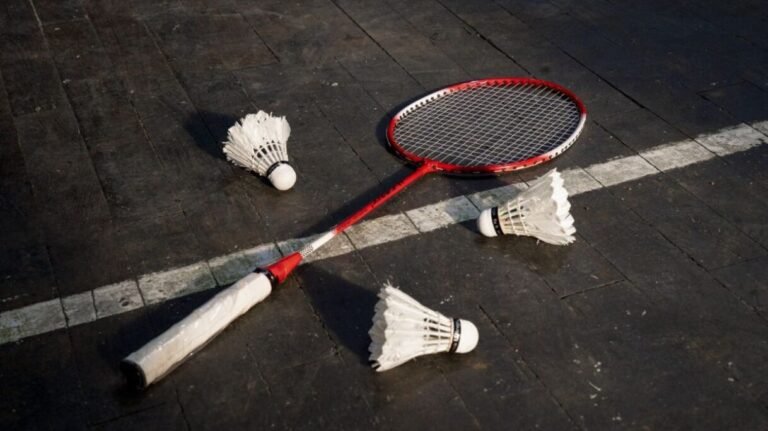Introduction: Why Badminton Captivates Everyone
Few sports combine lightning-quick action with elegance quite like badminton. Whether you’re rallying with friends in the backyard or watching professionals dart across the court during an international final, badminton delivers an adrenaline rush, demanding both physical finesse and strategic thinking. Let’s shuttle into this complete guide and discover why badminton remains one of the most beloved racquet sports globally.
Origins & Evolution of Badminton
Battledore & Shuttlecock: Ancient Roots
Long before modern courts and rackets, people across ancient India, China, and Greece played a simple yet engaging game battledore and shuttlecock aimed at keeping a feathered projectile airborne using paddles. This timeless pastime laid the groundwork for what badminton would become.
British India & the Birth of Modern Rules
In mid-19th century British India, army officers turned the traditional game into a competitive sport called “Poona.” By the 1870s, it had been imported to England and formalized at Badminton House giving the sport its modern name and codified structure.
Global Spread & Governing Bodies
Fast forward to 1934: the International Badminton Federation (today known as the Badminton World Federation, BWF) was established, laying the foundation for global competition and rule standardization. Olympic recognition arrived in 1992 in Barcelona, elevating badminton’s profile worldwide.
How Badminton Is Played Today
Court Layout & Match Format
Badminton is played indoors on a rectangular court divided by a net. Singles use a slightly narrower court, while doubles expand the width. Matches are best-of-three games, each played to 21 points with deuce rules and a golden point at 29-all.
Equipment Evolution: Racquets & Shuttlecocks
Originally, rackets were wooden and heavy. Over the decades, innovations brought aluminum and then carbon-fiber composites, resulting in incredibly lightweight yet powerful frames built for swift play. Shuttlecocks too have evolved from cork and feather construction to enhanced arrangements and synthetic alternatives.
Signature Strokes & Techniques
Players must master a variety of shots from powerful smashes and lunging net kills to deceptive slices, drops, and clears. Technique matters more than it appears: forehand and backhand motions, court positioning, and timing all shape outcomes. Strategy often centers on manipulating your opponent’s movement and response rather than mere brute force.
The Science & Athletic Demands
Physiology, Fitness & Biomechanics
Badminton is intensely demanding. Matches feature sharp, high-intensity rallies (often around 7 seconds each) interspersed with brief rest. Elite players usually operate at over 90% of their maximum heart rate. Movement relies heavily on explosive lunges, jumps, and rapid changes of direction highlighting both aerobic and anaerobic systems.
Visual Acuity & Rally Patterns
Beyond physical demands, badminton is about seeing in split seconds: elite players process shuttlecock trajectory and opponent movement instantly, enabling precise interception and shot placement.
Why Badminton Thrives Globally
Health & Social Benefits
Badminton is a great calorie-burner and stress-reliever; even casual play for an hour can burn hundreds of calories. It promotes cardiovascular health, coordination, mental agility, and social interaction making it a popular sport for all ages.
Fun Facts & Record-breaking Speeds
-
Widely acknowledged as the fastest racquet sport, with smashes exceeding 200 mph.
-
It’s one of the world’s most participated sports ranking second only to football globally.
Pro Tips for Players
Equipment Selection Guide
-
Racket: Choose based on balance (head-heavy for power; head-light for speed) and weight (lighter for beginners, slightly heavier for experienced players).
-
Shuttlecock: Goose-feather for consistency; synthetic for durability and windy conditions.
Training Drills & Match Strategy
-
Footwork drills: Shadow stepping, directional lunges, and recovery reps boost agility.
-
Shot variety: Practice deceptive net drops, defensive clears, and sharp smashes to stay unpredictable.
-
Endurance play: Alternate rally drills with recovery to simulate real match stress.
Common Mistakes & Corrections
-
Over-relying on power: Smart placement beats raw force.
-
Neglecting backhand practice: The backhand clear and smash are difficult master them to stay versatile.
Badminton Compared — Tennis & Other Racquet Sports
Unlike tennis, badminton matches are played with a shuttlecock that stops instantly upon landing. Racquets are significantly lighter, and the game demands more wrist flexibility and explosive bursts. Though tennis also features powerful serves, badminton’s fastest smashes still surpass tennis’s record serve speeds.
Conclusion: The Enduring Appeal of Badminton
Badminton captivates because it blends speed, strategy, accessibility, and athleticism in one dynamic package. Whether you’re a beginner mastering basic swings or an advanced player fine-tuning your smashes and footwork, the game offers endless challenge and reward. It’s fast. It’s fun. And above all, it brings people together across ages, backgrounds, and skill levels.
FAQs
Q1: Why is badminton considered the fastest racquet sport?
Because shuttlecocks can reach speeds over 200 mph, with record smashes crossing 330 km/h.
Q2: What makes badminton so physically demanding?
Elite matches involve high-intensity rallies with short rests, keeping players at very high heart rates and demanding explosive agility.
Q3: What fitness benefits does badminton offer?
It improves cardiovascular health, burns calories, enhances agility, relieves stress, and encourages social interaction.
Q4: How did badminton get its name?
It was named after Badminton House in England, where the sport was popularized in the mid-1800s.
Q5: How has badminton equipment evolved?
Rackets shifted from heavy wood to lightweight carbon composites, while shuttlecocks improved with feather arrangements and synthetic alternatives.
